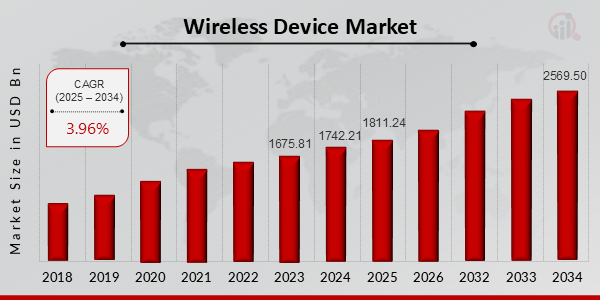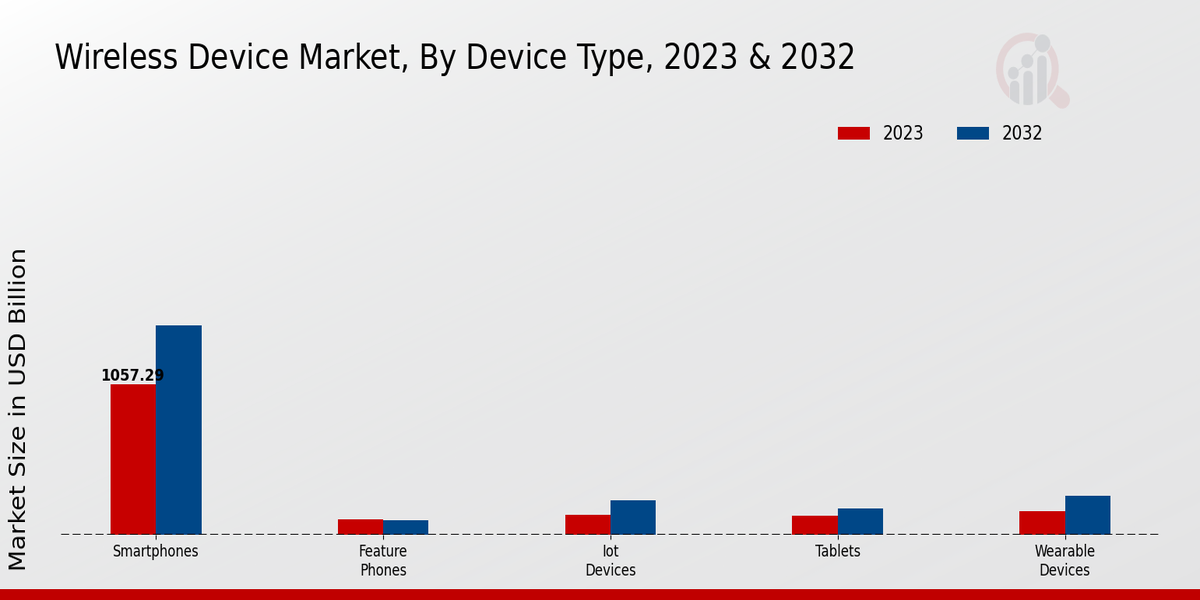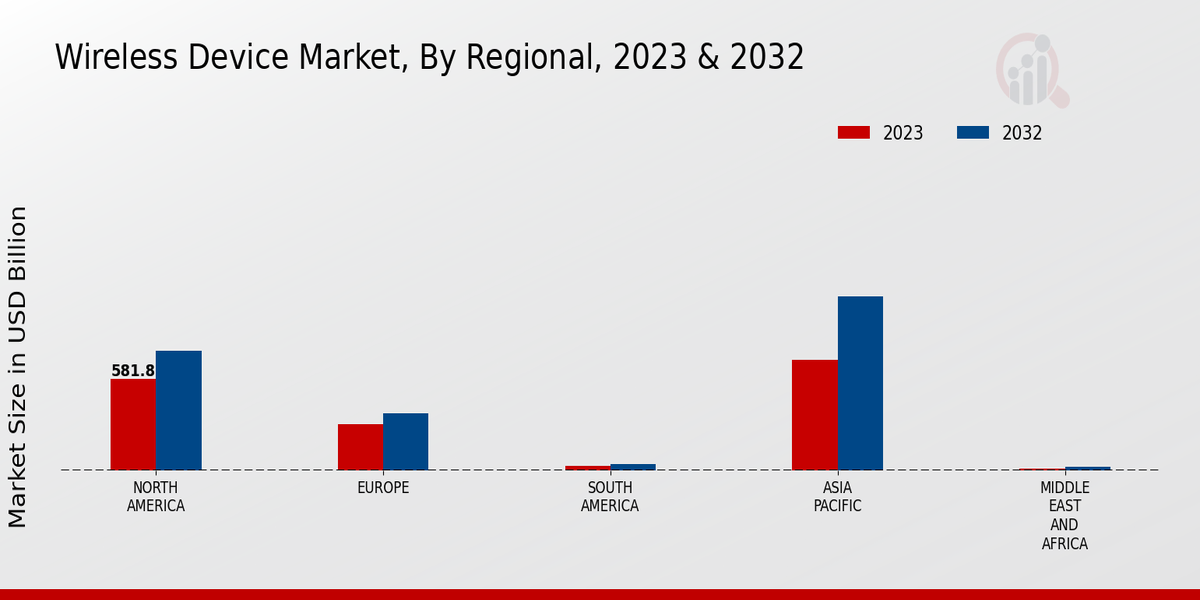Wireless Device Market Overview
Wireless Device Market is projected to grow from USD 1811.24 Billion in 2025 to USD 2569.50 Billion by 2034, exhibiting a compound annual growth rate (CAGR) of 3.96% during the forecast period (2025 - 2034). Additionally, the market size for Wireless Device Market was valued at USD 1742.21 billion in 2024.
Key Wireless Device Market Trends Highlighted
The Wireless Device Market is poised for significant growth, driven by advancements in technology and increasing demand for connectivity. The transition to 5G networks, with its enhanced speed and latency capabilities, is creating new opportunities for innovation and growth in the wireless device ecosystem. Moreover, the growing adoption of IoT devices and wearables is fueling the demand for wireless connectivity, driving market expansion.The rise of cloud gaming and streaming services is another key trend, enabling users to access high-quality entertainment on their wireless devices. The integration of artificial intelligence (AI) and machine learning (ML) in wireless devices is also transforming the user experience, enhancing device capabilities such as battery optimization and personalization. Additionally, the adoption of advanced materials and innovative designs is contributing to the development of lightweight, durable, and aesthetically appealing devices.
Fig 1 Wireless Device Market Overview( 2025-2034)

Source: Primary Research, Secondary Research, MRFR Database and Analyst Review
Wireless Device Market Drivers
Rising Demand for Mobile Internet Connectivity
One of the main contributing factors to the growth of the global wireless device market industry is the increasing penetration of smartphones and other mobile devices. More people now access the internet through their mobile devices, and this calls for more reliable and high-speed wireless networks. This trend is bound to continue over the next few years as the total number of people using mobile internet continues to rise. Another factor that drives the growth of the market is the increasing adoption of smartphones, tablets, and other wireless devices.The growing demand for mobile data services is another reason for the accelerated growth of the market. Mobile broadband services such as 4G and 5G are becoming increasingly popular thereby driving the growth of the market. Finally, the growing demand for these devices in emerging markets also helps in propelling the growth of the global wireless device market industry.
Growing Popularity of Internet of Things (IoT)
The Internet of Things (IoT) is a rapidly growing trend that is expected to have a major impact on the wireless device market. IoT devices are devices that are connected to the internet and can collect and share data. These devices are used in a wide range of applications, including home automation, industrial automation, and healthcare. The growing popularity of IoT devices is expected to drive the demand for wireless connectivity, as these devices need to be able to connect to the internet in order to function.The increasing adoption of IoT devices in various sectors such as healthcare, manufacturing, retail, and transportation is contributing to the growth of the Global Wireless Device Market Industry.
Technological Advancements
The wireless device market is constantly evolving, with new technologies being developed all the time. These technologies are making wireless devices more powerful, more efficient, and more affordable. For example, the development of 5G technology is expected to revolutionize the wireless device market, as it will provide much faster speeds and lower latency than previous generations of wireless technology. The advancements in wireless technologies, such as 5G and Wi-Fi 6, are enabling faster data transmission speeds and lower latency.This is making it possible for wireless devices to support new applications and services that require high bandwidth and low latency, such as augmented reality and virtual reality.
Wireless Device Market Segment Insights
Wireless Device Market Device Type Insights
In the Global Wireless Device Market, the device type has been segmented into smartphones, feature phones, IoT devices , tablets, and wearable devices. In 2023, the smartphone segment accounted for the largest market share and is expected to continue dominating the market over the forecast period. The market growth in the smartphone segment is attributed to the increasing demand for smartphones with advanced features, including high-resolution cameras, large displays, and powerful processors. Meanwhile, the feature phone segment’s market share is projected to decrease during the forecast period due to the growth in consumers’ preference for shifting to smartphones.
On the other hand, the IoT devices segment is anticipated to grow at a significant CAGR over the forecast period, as industries such as manufacturing, healthcare, and retail continue to adopt more IoT devices. In addition, the tablet segment is expected to grow at a healthy CAGR over the forecast period as more consumers use tablets for entertainment, productivity, and education. Smartphones are expected to continue being the largest segment of the market, accounting for more than 50% of the market share by 2032. The IoT devices segment is expected to grow at the fastest CAGR over the forecast period.
Fig 2 Wireless Device Market By Device Type ( 2023-2032)

Source: Primary Research, Secondary Research, MRFR Database and Analyst Review
Wireless Device Market Technology Insights
The Global Wireless Device Market segmentation by Technology includes 4G, 5G, Wi-Fi, Bluetooth, and NFC. Among these, 5G technology is expected to grow significantly in the coming years due to its high speed and low latency. The Global Wireless Device Market revenue for 5G is projected to reach USD 1,236.1 billion by 2026, growing at a CAGR of 49.9%. Wi-Fi is another major technology segment, with a projected market size of USD 264.7 billion by 2026. The growth of Wi-Fi is driven by the increasing demand for wireless connectivity in homes, offices, and public spaces.Bluetooth and NFC technologies are also expected to witness steady growth in the coming years. The rising adoption of Bluetooth-enabled devices, such as smartphones, laptops, and headphones, is driving the growth of the Bluetooth segment. Similarly, the growing use of NFC for mobile payments and other contactless transactions is contributing to the growth of the NFC segment.
Wireless Device Market Form Factor Insights
The Global Wireless Device Market is segmented by Form Factor, including Clamshell, Bar, Full-touch, Flip, and Foldable. The Full-touch segment dominated the market in 2023, accounting for a 68.9% revenue share. The increasing popularity of smartphones, tablets, and other devices that feature touchscreens has driven the growth of this segment. The Foldable segment is expected to grow rapidly in the coming years, with a projected CAGR of 25.1% from 2023 to 2032. This growth is driven by the increasing adoption of foldable smartphones and tablets, which offer a unique user experience and increased functionality.
Wireless Device Market Operating System Insights
The Global Wireless Device Market is segmented by Operating System into Android, iOS, Windows Mobile, KaiOS, and Other OS. Android led the market in 2023, accounting for over 70% of global revenue. iOS ranked second with a significant market share, followed by Windows Mobile, KaiOS, and Other OS. The dominance of Android is attributed to its open-source nature, wide availability of devices, and extensive app ecosystem. iOS is primarily used on Apple devices and is known for its user-friendly interface and premium app store. Windows Mobile has a limited market share due to competition from Android and iOS.KaiOS is gaining traction in emerging markets as an affordable and feature-rich operating system for low-end devices. Other OS includes various proprietary operating systems used by niche players. The Global Wireless Device Market is expected to grow at a CAGR of 3.96% from 2023 to 2032.
Wireless Device Market Regional Insights
The regional segmentation of the Global Wireless Device Market presents distinct dynamics and growth opportunities across different regions. North America continues to be a significant market, driven by the presence of leading technology companies and early adoption of advanced wireless technologies. The region is expected to maintain its dominant position, with a projected revenue of USD 654.3 billion by 2024. Europe is another key market, characterized by a high penetration of wireless devices and a focus on infrastructure development. The region is anticipated to reach a market value of USD 326.1 billion by 2024.APAC emerges as a rapidly growing market, driven by increasing disposable income, rising urbanization, and the expansion of mobile networks. The region is expected to witness a significant surge in wireless device adoption, with a projected revenue of USD 789.2 billion by 2024. South America and MEA represent emerging markets with untapped potential. These regions are expected to experience steady growth in wireless device adoption, supported by government initiatives and expanding network coverage.
Fig 3 Wireless Device Market Regional ( 2023-2032)

Source: Primary Research, Secondary Research, MRFR Database and Analyst Review
Wireless Device Market Key Players And Competitive Insights
Major players in Wireless Device Market industry are constantly striving to gain competitive advantage by offering innovative products and services, expanding their distribution channels, and engaging in strategic partnerships and acquisitions. Leading Wireless Device Market players invest heavily in research and development to stay ahead of the competition and meet the evolving demands of consumers. The Wireless Device Market Competitive Landscape is characterized by a mix of established players and emerging challengers, each with its own strengths and weaknesses.
The industry is also subject to regulatory changes and technological advancements, which can impact the competitive dynamics and market share of individual players.A leading player in the Wireless Device Market, , has established a strong brand reputation and a loyal customer base through its commitment to innovation and customer satisfaction. The company offers a wide range of wireless devices, including smartphones, tablets, and wearables, and is known for its sleek designs and feature-rich products. 's distribution network spans multiple channels, including online marketplaces, retail stores, and carrier partnerships, ensuring that its products are accessible to a global audience. The company has also formed strategic partnerships with key players in the industry to expand its reach and enhance its product offerings.
A competitor company in the Wireless Device Market, , is known for its focus on affordability and value. The company offers a range of budget-friendly wireless devices that cater to the needs of price-conscious consumers. 's products are typically less feature-rich than those of premium brands, but they offer reliable performance and meet the basic communication and entertainment needs of users. The company has a strong presence in emerging markets and has been successful in gaining market share by targeting price-sensitive consumers. Its distribution network primarily consists of online marketplaces and budget-friendly retail stores, allowing it to reach a wide audience while keeping costs low.
Key Companies in the Wireless Device Market Include
- Samsung
- Realme
- Oppo
- Xiaomi
- Vivo
- Nokia
- Huawei
- Sony
- HTC
- Google
- LG
- Motorola
- OnePlus
- Apple
Wireless Device Market Industry Developments
The global wireless device market is projected to reach USD 2,287.0 billion by 2032, exhibiting a CAGR of 3.96% from 2024 to 2032. The growth is attributed to increasing smartphone penetration, rising demand for connected devices, and advancements in wireless technologies such as 5G and Wi-Fi 6. Emerging markets, such as Asia-Pacific, are expected to drive growth due to increasing disposable income and urbanization. Key players in the market include Apple, Samsung, Huawei, and Xiaomi. Recent developments include the launch of foldable smartphones, the growing adoption of eSIM technology, and the integration of artificial intelligence (AI) into wireless devices. The market is expected to face challenges such as supply chain disruptions and competition from emerging technologies like satellite communication.
Wireless Device Market Segmentation Insights
-
Wireless Device Market Device Type Outlook
- Smartphones
- Feature Phones
- IoT Devices (Cellular Connected)
- Tablets
- Wearable Devices
-
Wireless Device Market Technology Outlook
- 4G
- 5G
- Wi-Fi
- Bluetooth
- NFC
-
Wireless Device Market Form Factor Outlook
- Clamshell
- Bar
- Full-touch
- Flip
- Foldable
-
Wireless Device Market Operating System Outlook
- Android
- iOS
- Windows Mobile
- KaiOS
- Other OS
-
Wireless Device Market Regional Outlook
- North America
- Europe
- South America
- Asia Pacific
- Middle East and Africa
|
Report Attribute/Metric
|
Details
|
|
Market Size 2024
|
1742.21 (USD Billion)
|
|
Market Size 2025
|
1811.24 (USD Billion)
|
|
Market Size 2034
|
2569.50 (USD Billion)
|
|
Compound Annual Growth Rate (CAGR)
|
3.96% (2025 - 2034)
|
|
Report Coverage
|
Revenue Forecast, Competitive Landscape, Growth Factors, and Trends
|
|
Base Year
|
2024
|
|
Market Forecast Period
|
2025 - 2034
|
|
Historical Data
|
2019 - 2023
|
|
Market Forecast Units
|
USD Billion
|
|
Key Companies Profiled
|
Samsung, Realme, Oppo, Xiaomi, Vivo, Nokia, Huawei, Sony, HTC, Google, LG, Motorola, OnePlus, Apple
|
|
Segments Covered
|
Device Type, Technology, Form Factor, Operating System, Regional
|
|
Key Market Opportunities
|
5G network expansion IoT device proliferation Augmented and Virtual Reality ARVR applications AIpowered wireless devices Smart city and connected infrastructure
|
|
Key Market Dynamics
|
Rising demand for 5G connectivity Growing adoption of IoT devices Advancements in AI and ML Increasing popularity of cloudbased services Expansion of wireless networks in emerging markets
|
|
Countries Covered
|
North America, Europe, APAC, South America, MEA
|
Frequently Asked Questions (FAQ) :
The global wireless device market is anticipated to reach a valuation of 1742.21 billion USD in 2024.
The global wireless device market is projected to grow at a CAGR of 3.96% from 2025 to 2034.
North America is anticipated to account for the largest market share in the global wireless device market in 2024.
Increasing adoption of smartphones, rising demand for mobile data, and advancements in wireless technologies are among the key factors driving the growth of the market.
Major players in the global wireless device market include Apple, Samsung, Huawei, Xiaomi, and Oppo.
Wireless devices find applications in various sectors, including communication, entertainment, healthcare, and education.
The global wireless device market is projected to reach a valuation of 2569.50 billion USD by 2034.
The Asia-Pacific region is expected to exhibit the highest growth rate in the global wireless device market from 2025 to 2034.
Key trends include the proliferation of 5G technology, the rise of IoT devices, and the convergence of wireless and wired networks.
Challenges include supply chain disruptions, geopolitical uncertainties, and intense competition.

















